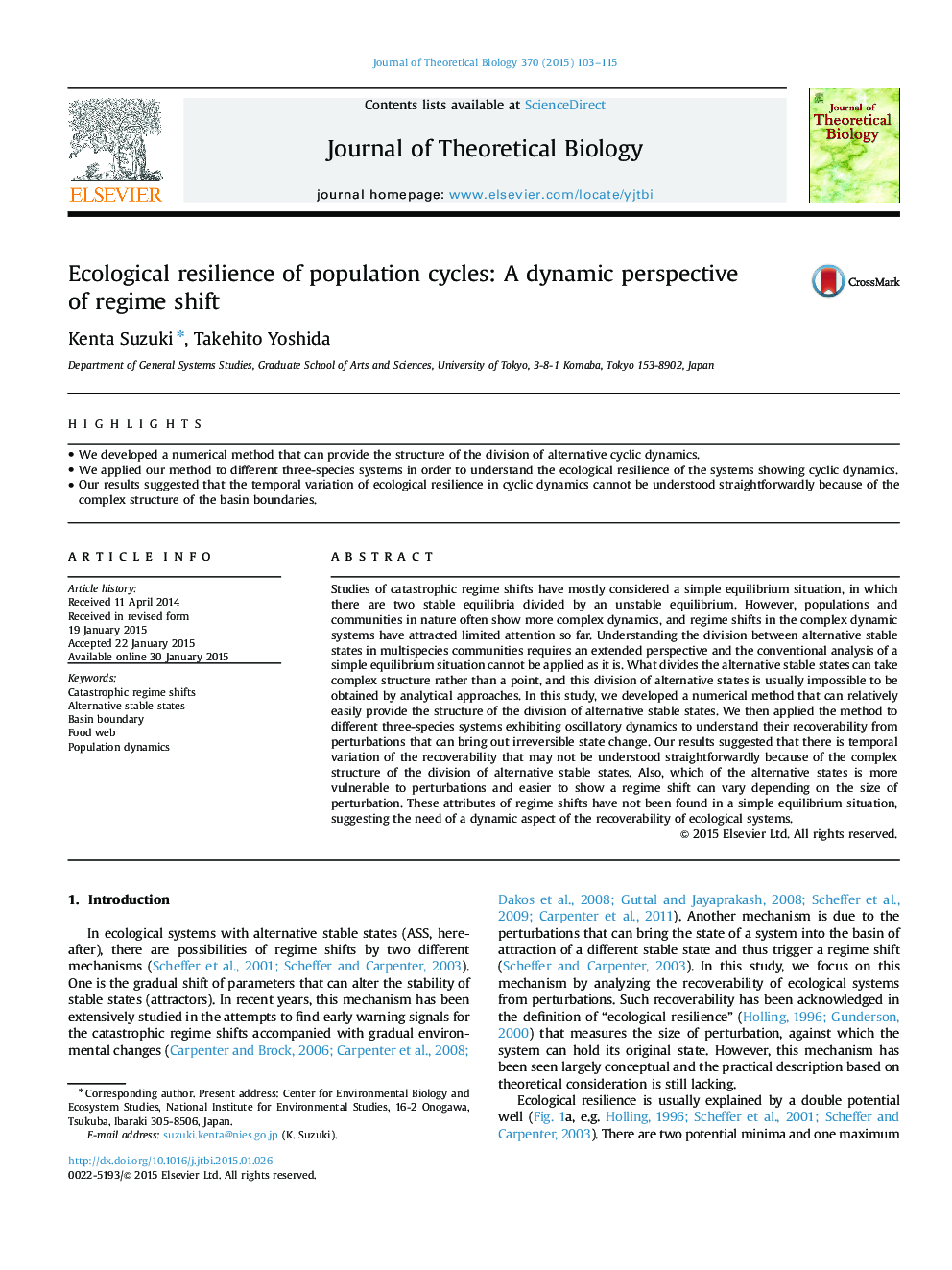| کد مقاله | کد نشریه | سال انتشار | مقاله انگلیسی | نسخه تمام متن |
|---|---|---|---|---|
| 6369921 | 1623840 | 2015 | 13 صفحه PDF | دانلود رایگان |
عنوان انگلیسی مقاله ISI
Ecological resilience of population cycles: A dynamic perspective of regime shift
ترجمه فارسی عنوان
انعطاف پذیری اکولوژیکی چرخه های جمعیت: یک چشم انداز پویا از تغییر رژیم
دانلود مقاله + سفارش ترجمه
دانلود مقاله ISI انگلیسی
رایگان برای ایرانیان
کلمات کلیدی
تغییر رژیم فاجعه بار، کشورهای ثبات جایگزین، مرز حوضه، وب غذایی، دینامیک جمعیت،
ترجمه چکیده
مطالعات مربوط به تغییرات رژیم فاجعه بار بیشتر به یک حالت تعادل ساده در نظر گرفته شده است که در آن دو تعادل پایدار با یک تعادل ناپایدار تقسیم می شود. با این حال، جمعیت ها و جوامع در طبیعت اغلب پویایی پیچیده ای را نشان می دهند، و تغییر رژیم در سیستم های دینامیکی پیچیده تا کنون توجه محدودی را به خود جلب کرده است. درک تقسیم بین حالت های با ثبات جایگزین در جوامع چندگانه، نیازمند چشم انداز گسترده ای است و تجزیه و تحلیل متعارف یک وضعیت تعادل ساده نمی تواند در آن صورت پذیرد. آنچه که دولتهای جایگزین پایدار را می شکند می تواند به جای یک نقطه، ساختاری پیچیده ای را ایجاد کند و این تقسیم کشورهای جایگزین معمولا با روش های تحلیلی غیرممکن است. در این مطالعه، ما یک روش عددی را ایجاد کردیم که نسبتا ساده ساختن تقسیم حالت های پایدار جایگزین را فراهم می کند. سپس روش را برای سیستم های سه گانه مختلف در نظر گرفتیم تا دینامیکی نوساناتی را برای درک توانایی بازیابی آنها از اختلالاتی که می تواند تغییر وضعیت غیر قابل برگشت را به دست آورد، اعمال کرد. نتایج ما نشان می دهد که تنوع زمانی از قابلیت بازیابی وجود دارد که ممکن است به علت ساختار پیچیده تقسیم حالت های با ثبات جایگزین به راحتی قابل درک نیست. همچنین، کدام یک از کشورهای جایگزین در برابر آشفتگی ها آسیب پذیرتر است و به راحتی نشان می دهد که تغییر رژیم بسته به اندازه اختلال، متفاوت است. این مشخصه های تغییر رژیم در یک وضعیت تعادل ساده یافت نشد، که بیانگر نیاز به یک جنبه پویا از قابلیت بازیابی سیستم های زیست محیطی است.
موضوعات مرتبط
علوم زیستی و بیوفناوری
علوم کشاورزی و بیولوژیک
علوم کشاورزی و بیولوژیک (عمومی)
چکیده انگلیسی
Studies of catastrophic regime shifts have mostly considered a simple equilibrium situation, in which there are two stable equilibria divided by an unstable equilibrium. However, populations and communities in nature often show more complex dynamics, and regime shifts in the complex dynamic systems have attracted limited attention so far. Understanding the division between alternative stable states in multispecies communities requires an extended perspective and the conventional analysis of a simple equilibrium situation cannot be applied as it is. What divides the alternative stable states can take complex structure rather than a point, and this division of alternative states is usually impossible to be obtained by analytical approaches. In this study, we developed a numerical method that can relatively easily provide the structure of the division of alternative stable states. We then applied the method to different three-species systems exhibiting oscillatory dynamics to understand their recoverability from perturbations that can bring out irreversible state change. Our results suggested that there is temporal variation of the recoverability that may not be understood straightforwardly because of the complex structure of the division of alternative stable states. Also, which of the alternative states is more vulnerable to perturbations and easier to show a regime shift can vary depending on the size of perturbation. These attributes of regime shifts have not been found in a simple equilibrium situation, suggesting the need of a dynamic aspect of the recoverability of ecological systems.
ناشر
Database: Elsevier - ScienceDirect (ساینس دایرکت)
Journal: Journal of Theoretical Biology - Volume 370, 7 April 2015, Pages 103-115
Journal: Journal of Theoretical Biology - Volume 370, 7 April 2015, Pages 103-115
نویسندگان
Kenta Suzuki, Takehito Yoshida,
